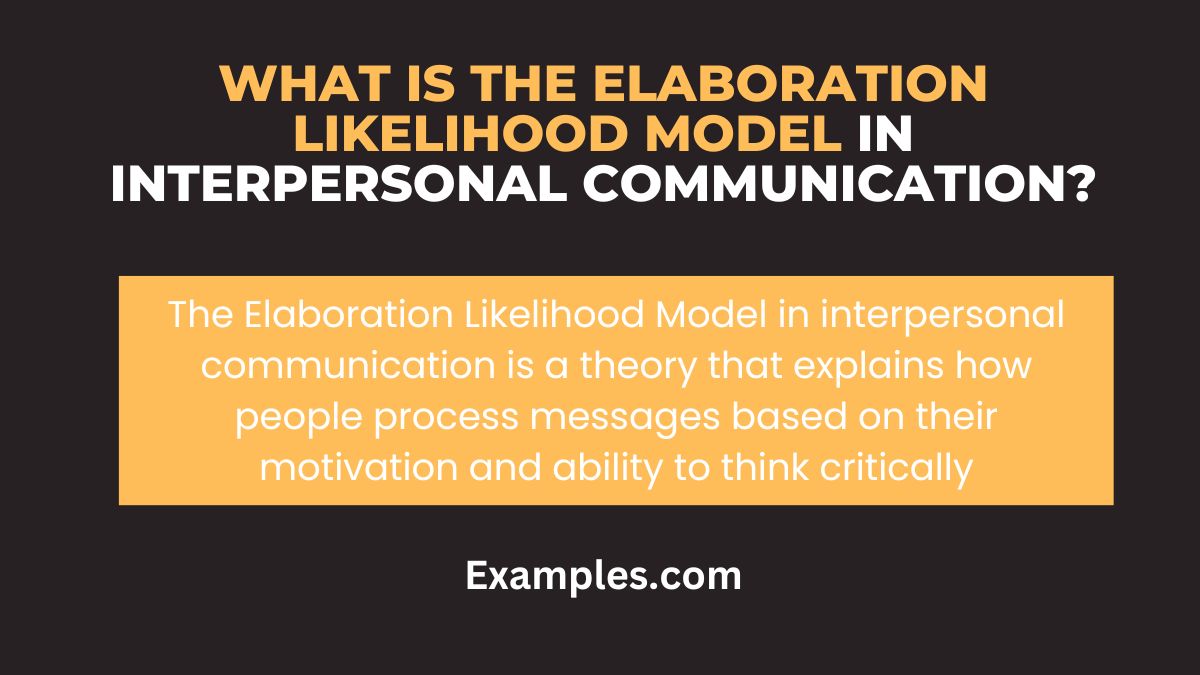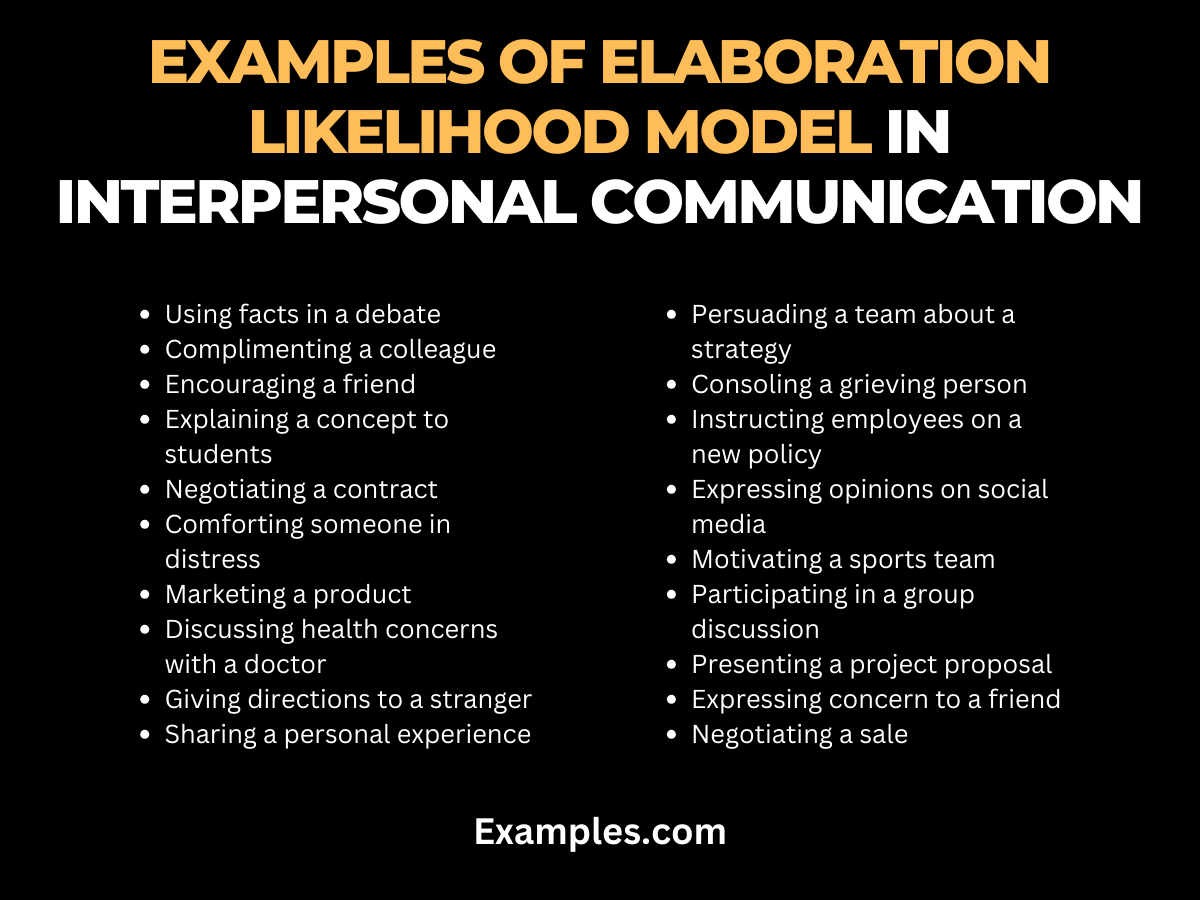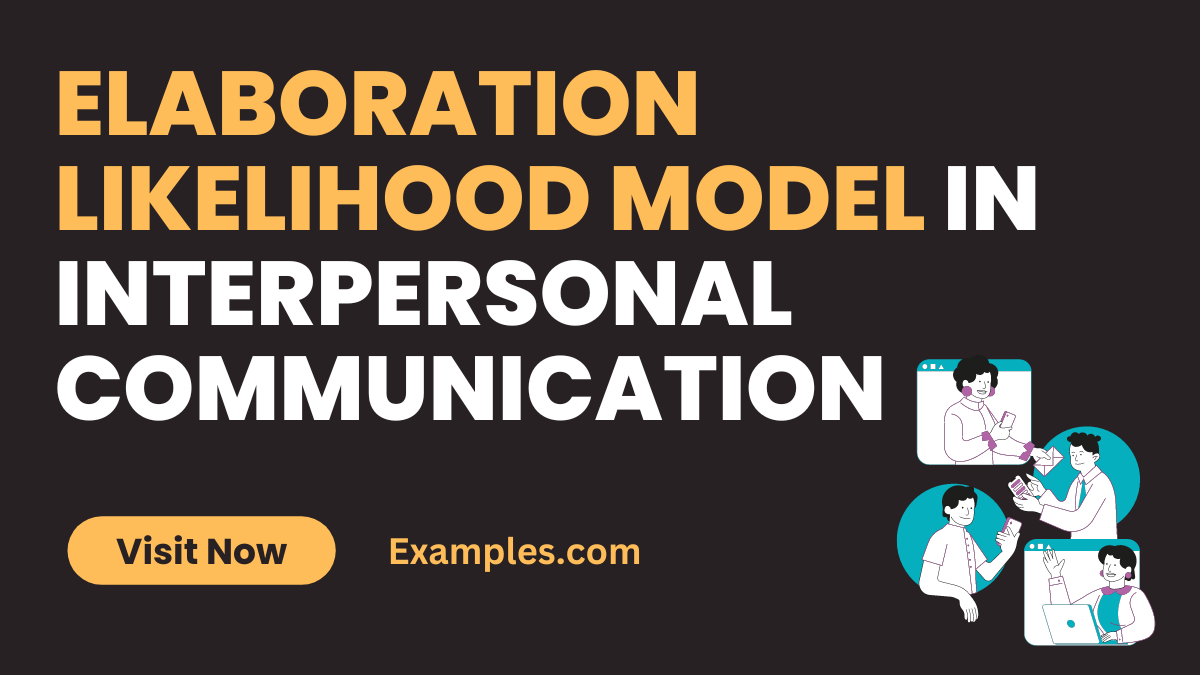19+ Elaboration Likelihood Model in Interpersonal Communication Examples
In the realm of interpersonal communication, the Elaboration Likelihood Model (ELM) stands out as a pivotal theory. This comprehensive guide delves into the intricacies of ELM, highlighting its vital role in understanding and enhancing our communication methods. Whether you’re a student, professional, or a communication enthusiast, understanding the Elaboration Likelihood Model in Interpersonal Communication is key to mastering the art of effective interaction. Embrace this journey through ELM’s concepts, applications, and transformative potential in everyday communication.
What is the Elaboration Likelihood Model in Interpersonal Communication?

The Elaboration Likelihood Model in Interpersonal Communication is a theory that explains how people are persuaded in different communication contexts. It distinguishes between two paths of persuasion: the central route and the peripheral route. Central route persuasion occurs when a person is persuaded by the content of the message, while peripheral route persuasion happens when a person is influenced by something other than the message’s content, like the speaker’s credibility or attractiveness. Understanding these routes can significantly enhance effective communication strategies.
History
Who Created: Richard E. Petty and John T. Cacioppo
Date: 1980s
Their pioneering work stemmed from the need to understand how and why people change their attitudes and beliefs. Petty and Cacioppo’s model has since become a fundamental tool in the study of persuasion in interpersonal communication, providing insights into how individuals process and respond to persuasive messages. This model has had a profound impact on the history & scientific study of interpersonal communication, shaping how we perceive and engage in persuasive communication.
What is the Best Example of Elaboration Likelihood Model in Interpersonal Communication?
A prime example of the Elaboration Likelihood Model in action can be seen in advertising campaigns. Consider a health-related campaign aiming to persuade individuals to adopt healthier lifestyles. The central route would involve presenting scientific evidence and logical arguments about the benefits of a healthy lifestyle. In contrast, the peripheral route might use celebrity endorsements or emotional appeals. This distinction illustrates how different methods of persuasion are employed depending on the audience’s level of involvement and motivation to process the information.
20 Examples of Elaboration Likelihood Model in Interpersonal Communication

The Elaboration Likelihood Model (ELM) plays a pivotal role in Interpersonal Communication, influencing how messages are processed and ensuring effective communication. This model emphasizes the importance of the audience’s motivation and ability to process information, distinguishing between central and peripheral routes of persuasion. Here, we explore 20 unique examples showcasing the application of ELM in various types of Interpersonal Communication.
- Using facts in a debate: In a formal debate, presenting strong, logical arguments engages the central route, encouraging deep processing of information.
Example: “The statistics from the latest study clearly show a 30% improvement.” - Complimenting a colleague: When complimenting a colleague, peripheral cues like tone and sincerity are crucial for the message’s effectiveness.
Example: “I really admire how you handled that project. Great job!” - Encouraging a friend: To motivate a friend, positive reinforcement and emotional support utilize the peripheral route.
Example: “You always have such creative solutions; I’m sure you’ll figure this out.” - Explaining a concept to students: Teachers use clear, logical explanations to engage students’ central processing.
Example: “Let’s break down the theory into simpler parts for better understanding.” - Negotiating a contract: Effective negotiation involves presenting logical arguments, focusing on the central route of persuasion.
Example: “Based on market analysis, our proposal offers the best value.” - Comforting someone in distress: Using empathetic language and tone, one can connect emotionally, activating the peripheral route.
Example: “I understand it’s tough, but I’m here for you.” - Marketing a product: Advertisements often use attractive visuals or celebrity endorsements, capitalizing on peripheral cues.
Example: “Join the millions, including your favorite stars, who love our product.” - Discussing health concerns with a doctor: Medical discussions require factual, detailed information, engaging the central route.
Example: “Your symptoms suggest a possible vitamin deficiency.” - Giving directions to a stranger: Clear, concise instructions rely on central processing for effective communication.
Example: “Go straight for two blocks, then turn left at the traffic light.” - Sharing a personal experience: Storytelling often involves emotional elements, engaging listeners through the peripheral route.
Example: “That trip was a life-changing experience for me.” - Persuading a team about a strategy: Presenting logical reasons and data to a team utilizes the central route for effective persuasion.
Example: “Our research shows this strategy increases efficiency by 40%.” - Consoling a grieving person: Empathy and understanding are key, engaging peripheral processing in such sensitive interactions.
Example: “It’s hard, but remember, you’re not alone in this.” - Instructing employees on a new policy: Clear, logical explanations ensure employees understand new policies through central processing.
Example: “This policy is designed to streamline our workflow effectively.” - Expressing opinions on social media: Emotive language and imagery on social platforms often engage the peripheral route.
Example: “This breathtaking scene is why we must protect our environment.” - Explaining technical details to a client: Detailed, logical explanations are necessary for clients to understand technical aspects.
Example: “Our software optimizes your system by automating these processes.” - Motivating a sports team: Inspirational speeches often rely on emotional appeal, engaging the peripheral route of persuasion.
Example: “We have the skill and determination to win this game!” - Participating in a group discussion: Using factual information and logical arguments engages participants’ central processing.
Example: “Let’s consider the long-term impacts of this decision.” - Presenting a project proposal: A well-structured presentation with logical arguments appeals to the central route of persuasion.
Example: “Our analysis shows a projected 20% growth with this project.” - Expressing concern to a friend: Showing genuine concern and empathy engages the peripheral route in personal conversations.
Example: “I’ve noticed you’ve been quiet lately. Is everything okay?” - Negotiating a sale: Effective sales tactics often combine factual information with persuasive, emotive language.
Example: “This model not only offers advanced features but also guarantees reliability”
Assumptions of Elaboration Likelihood Model in Interpersonal Communication
- Central vs. Peripheral Routes: The model assumes two primary routes to persuasion – the central route, which is logic-driven and uses factual evidence and data, and the peripheral route, which relies on superficial cues, such as attractiveness or celebrity status.
- Involvement Level: It considers the audience’s level of involvement in the communication. High involvement leads to the central route, while low involvement leads to the peripheral route.
- Motivation to Process: The model assumes that people are more likely to engage in careful, critical thinking if they are motivated to process the information being presented.
- Ability to Process: Alongside motivation, the ability to process information (based on factors like intelligence or prior knowledge) is a key assumption.
- Nature of the Message: The effectiveness of a message depends on its nature, whether it’s logical and fact-based for the central route or aesthetic and emotional for the peripheral route.
- Cognitive Responses: The model assumes that people generate cognitive responses to persuasive messages, which can either be supportive, neutral, or counter-arguing.
- Quality of Arguments: It’s assumed that the quality of arguments in a message influences the persuasion process, especially for those following the central route.
- Bi-Directional Persuasion: The model acknowledges that persuasion can be bi-directional, leading either to attitude change or reinforcement of existing beliefs.
- Role of Peripheral Cues: Peripheral cues can change attitudes without requiring deep processing of the message content.
- Durability and Predictability: Attitude changes that result from the central route are more likely to persist over time and predict future behavior than those from the peripheral route.
What are the Stages of Elaboration Likelihood Model in Interpersonal Communication?
- Message Reception: The first stage involves the audience receiving the message.
- Initial Processing: Determining whether the message is relevant or interesting.
- Route Determination: Deciding on the central or peripheral route based on involvement and ability.
- Message Evaluation: Critically analyzing the message if on the central route.
- Generation of Cognitive Responses: Forming thoughts about the message, which could be positive, negative, or neutral.
- Attitude Formation or Change: Based on the cognitive responses, attitudes may be formed or altered.
- Incorporation of Peripheral Cues: If on the peripheral route, non-content cues are more influential.
- Outcome of Persuasion: The end result is either a change in attitude or reinforcement of existing beliefs.
- Assessment of Persuasion Efficacy: Evaluating how effective the message was in changing attitudes.
- Long-Term Impact: Finally, assessing the durability and predictability of the attitude change.
The Elaboration Likelihood Model in interpersonal communication is essential for effective persuasion. By understanding the central and peripheral routes, you can tailor your messages to your audience’s needs. Engaging in thoughtful, fact-based discussions while also utilizing emotional cues when appropriate ensures your communication resonates and influences positively. Use this guide as a foundation to enhance your communication skills and connect more effectively with others.



